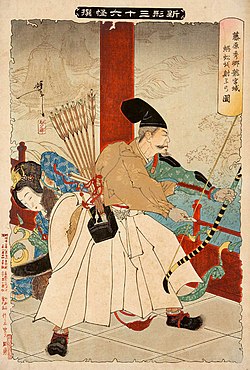Fujiwara no Hidesato

Fujiwara no Hidesato (
Hidesato served under Emperor Suzaku, and fought alongside Taira no Sadamori in 940 in suppressing the revolt of Taira no Masakado.[1] His prayer for victory before this battle is commemorated in the Kachiya Festival. Hidesato was then appointed Chinjufu shōgun (Defender of the North) and Governor of Shimotsuke Province.
According to legend, he slayed a giant centipede in Ōmi Province that plagued the Dragon Palace. He was also nicknamed Tawara Tōda.
Hidesato in legend
[edit]Hidesato, also known by the moniker Tawara Tōda or Tawara no Tōta,[2] is known in legend for his exploit of slaying the giant centipede (mukade[3]) of Mount Mikami.[2] Hidesato was recruited to this task by a giant dragon-snake which was, in fact, a resident of the Ryūgū-jō (Dragon Palace). Hidesato meets the Dragon King and is showered with rewards, which included an inexhaustible rice-sack (tawara), from which he allegedly earned his nickname.[4][5] A more rational explanation is that Tawara, also written differently as "
This centipede story, The Tale of Tawara Tōda, together with a romanticized account of his Masakado expedition comprise the Tawara Tōda Monogatari. The monogatari texts have been copied and printed profusely in picture scrolls and illustrated books throughout the Edo Period.[5][4]
Legendary arms
[edit]The Ise Shrine's Jingū Chōkokan Museum houses two swords that allegedly once belonged to Hidesato.
One is the Kenukigata tachi (Ise), a tachi of the kenukigata or "tweezer" type.[7][a] According to tradition, it was the sword obtained by Hidesato from the Dragon Palace, which later became an heirloom of the Akahori clan. After changing hands several times, it came into the possession of the shrine in 1793.[9] Although the Hidesato provenance is unverifiable, this sword is dated to be of the correct period.[9] The other alleged Hidesato sword at the museum is called Mukadegiri "Centipede-cutter".[10] Although its inscriptions claim it to be the work of the swordsmith Shinsoku (
There is also another "tweezer" type sword alleged to have belonged to Hidesato held in Chikubu Island, the Kenukigata tachi (Hōgon-ji).[12][13][14]
Genealogy
[edit]- Father: Fujiwara no Murao (
藤原 村 雄 ) - Mother: daughter of Shimatsuke-no-jō no Kashima (
下野 掾 鹿島 女 )- Wife: daughter of Minamoto no Michi (
源 通 ) of the Board of Chamberlains (侍従 ).- Son: Fujiwara no Chitsune (
藤原 千 常 )
- Son: Fujiwara no Chitsune (
- Children by unknown mother:
- Son: Fujiwara no Chitoki (
藤原 千 時 ) - Son: Fujiwara no Chiharu (
藤原 千晴 ) - Son: Fujiwara no Chikuni (
藤原 千 国 ) - Son: Fujiwara no Chigusa (
藤原 千種 ) - Daughter Hintia no Chigusa (
藤原 千種 )
- Son: Fujiwara no Chitoki (
- Wife: daughter of Minamoto no Michi (
Descendants
[edit]Many samurai clans claim descent from Hidesato, including the Northern Fujiwara (Ōshū branch of the Fujiwara clan). Some of the others are the Satō, Ōtomo, Mutō, Satō, Iga, Hatano, Oyama, Yūki and Shimokōbe clans.[15][16]
See also
[edit]- Kaze to Kumo to Niji to, a Japanese drama
Explanatory notes
[edit]References
[edit]![]() Media related to Fujiwara no Hidesato at Wikimedia Commons
Media related to Fujiwara no Hidesato at Wikimedia Commons
- ^ Turnbull, Stephen (1998). The Samurai Sourcebook. Cassell & Co. p. 199. ISBN 1854095234.
- ^ Jump up to: a b Sato, Hiroaki (1983). Legends of the Samurai. Kodansha International. p. 38. ISBN 9781590207307.
- ^ Foster, Michael Dylan (2009). Pandemonium and Parade: Japanese Monsters and the Culture of Yōkai. University of California Press. p. 139. ISBN 978-0-520-25361-2.
- ^ Jump up to: a b Araki, James T. (1981). "Otogi-zōshi and Nara ehon: A Field of Study in Flux". Monumenta Nipponica. 36: 1–5. doi:10.2307/2384084. JSTOR 2384084.
- ^ Jump up to: a b Kimbrough, R. Keller (2018). "The Tale of Tawara Tōda". Monsters, Animals, and Other Worlds: A Collection of Short Medieval Japanese Tales. Columbia University Press. ISBN 9780231545501.
- ^ Visser, Marinus Willem de (1913), The dragon in China and Japan, Amsterdam: J. Müller, pp. 191–193
- ^ Satō, Kanzan (1995). The Japanese Sword: a comprehensive guide. Translated by Joe Earle. The Overlook Press. p. 132. ISBN 9780870115622.
- ^ Harada, Kazutoshi (2009). Art of the Samurai: Japanese Arms and Armor, 1156-1868. Metropolitan Museum of Art. p. 197. ISBN 9781588393456.
- ^ Jump up to: a b Jungu Chōko Museum Agriculture Pavillion (1941). Jingū Chōkokan chinretsuhin zuroku
神宮 徴 古館 陳列 品 図録 (in Japanese). pp. 23–24. - ^ Jump up to: a b "Hidesato ni shōten, bushi no rūtsu shitte Tochigi-ken hakubutsukan de kikakuten dentō no hōtō Mukadegiri mo"
秀 郷 に焦点 、武士 のルーツ知 って栃木 県立 博物館 で企画 展 伝説 の宝刀 「蜈蚣 切 」も. Sankei Shinbun (in Japanese). 2018-11-19. - ^ Matsudaira, Sadanobu, ed. (1905), "Ise no kuni dai jingū zō Tawara Todō Hidesato Mukadekiri tachi (no) zu"
伊勢 国 大神宮 蔵 俵 藤太 秀 郷 蜈蚣 切 太刀 図 , Shūko jusshu tōken no bu集 古 十 種 刀剣 之 部 (in Japanese), Ikubunsha, p. (1)4 - ^ Bureau of Religions, Ministry of Education (1920). Handbook of the Old Shrines and Temples and Their Treasures in Japan. Sanshusha. p. 13.
- ^ Matsudaira, Sadanobu, ed. (1905), "Ōmi no kuni Chikubushima zō Tawara Todō Hidesato shonō tachi (no) zu"
近江 国 竹生島 社 蔵 俵 藤太 秀 郷 所 納 太刀 図 , Shūko jusshu tōken no bu集 古 十 種 刀剣 之 部 (in Japanese), Ikubunsha, p. (2)18 - ^ Honma, Junji; Satō, Kan'ichi (1966), Nihontō zenshū dai-6 kan (Nihontō no fūzoku)
日本 刀 全集 第 6巻 (日本 刀 の風俗 ) (in Japanese), Tokuma Shoten, p. 53 - ^ Frédéric, Louis (2002). "Otogi-zōshi and Nara ehon: A Field of Study in Flux". Japan Encyclopedia. Cambridge, Massachusetts: Harvard University. p. 220. ISBN 9780674017535.
- ^ Friday (2008), p. 150.
- Bibliography
- Friday, Karl (2008). "The Tale of Tawara Toda". The First Samurai: The Life and Legend of the Warrior Rebel, Taira Masakado. John Wiley & Sons. pp. 150–158. ISBN 9780471760825.

